|
Battle of South Mills
North Carolina and the Civil War
Battle of South Mills
Other Names: Camden
Location: Camden County
Campaign: Burnside's North Carolina Expedition (February-June 1862)
Date(s): April 19,
1862
Principal Commanders: Brig. Gen. Jesse Lee Reno [US]; Col. Ambrose
Wright [CS]
Forces Engaged: 21st Massachusetts and 51st Pennsylvania [US];
3rd Georgia [CS]
Estimated Casualties: 150 total (US
120; CS 30)
Result(s): Inconclusive (Federals withdrew.)
| Battle of South Mills |
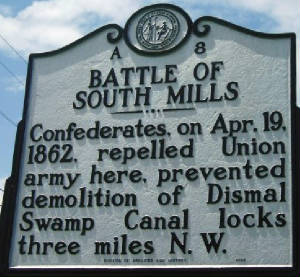
|
| Battle of South Mills |
| Battle of South Mills Map |
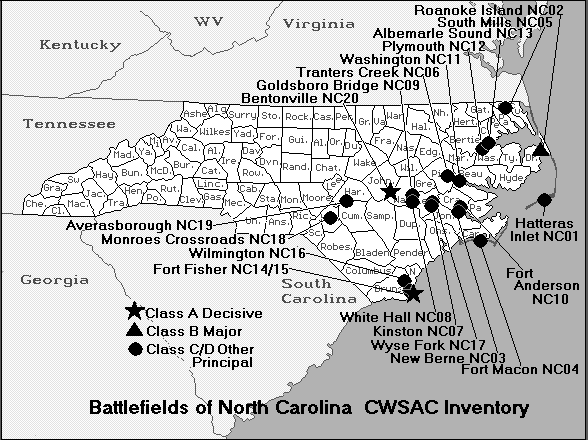
|
| Civil War Battle of South Mills History |
Introduction: Camden
County, North Carolina, was settled when English settlers drifted down the Pasquotank River from the Virginia colony. Camden
County had an important role to play in the Revolutionary War, contributing 416 officers and soldiers, the most of any county
in northeast North Carolina. The county split from Pasquotank County in 1777 to become an independent county. George Washington
commissioned the construction of the Dismal Swamp Canal, which took twelve years to build; the construction period lasted
from 1793 to 1805. The dirt that was excavated for the canal was used to build the bed of a toll road. (The location of the
toll road is now the location of U.S. Highway 17.) The construction of the canal brought many economic benefits to the village
of South Mills, such as the construction of mills near the southern locks of the canal. During the Civil War, the Battle of
South Mills would be fought near the village on April 19, 1862.
Summary: Learning that the Confederates
were building ironclads at Norfolk,
Burnside planned an expedition to destroy the Dismal Swamp Canal locks to prevent transfer of the ships to Albemarle Sound. He entrusted the operation to Brig. Gen. Jesse Lee Reno’s command, which
embarked on transports from Roanoke Island on April 18. By midnight, the convoy reached Elizabeth City and began disembarking troops.
On the morning of April 19, Reno marched north on the road to South Mills. At the crossroads a few miles below South
Mills, elements of Col. Ambrose Wright’s command delayed the Federals until dark. Reno
abandoned the expedition and withdrew during the night to the transports at Elizabeth
City. The transports carried Reno’s
troops to New Bern where they arrived on April 22. Although the fight at South Mills was the only battle near the canal, wartime
activity left the canal in a deplorable condition.
Background: Union General
Ambrose Burnside’s expedition into eastern North Carolina in 1862 scored a series of successes with the capture of Roanoke
Island in February, New Bern, and Washington in March, and Fort Macon in April. (See also North Carolina Coast and the American Civil War.) Among the few Confederate victories in that season was the defeat of a force sent to destroy the Dismal Swamp Canal
locks at South Mills. (See also Civil War Battle of South Mills, by D. H. Hill, Jr.)
Burnside ordered 3,000 men under
General Jesse Reno to blow up the locks in order to preclude the chance that Confederate ironclad gunboats might be
floated down the canal from Norfolk. The troops landed just south of Elizabeth City on the evening of April 18. Carrying with them two wagons of explosives, the Federals made a strategic error
by taking a wrong road and adding ten miles to their overland route north. (They executed the mulatto guide who had misled
them.) Weary and robbed of any chance of surprise, the Union troops meet 900 Confederates, commanded by Colonel Ambrose Wright,
a few miles below South Mills.
| Civil War on the Coast : Battle of South Mills |
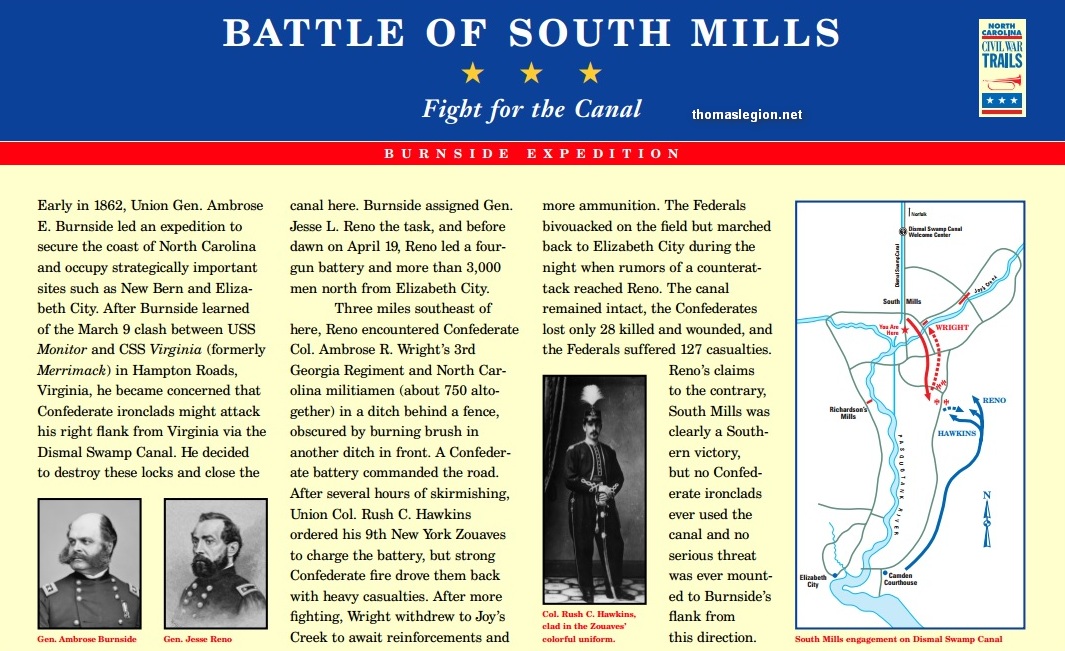
|
| Battle of South Mills, North Carolina |
| Great Dismal Swamp & South Mills |
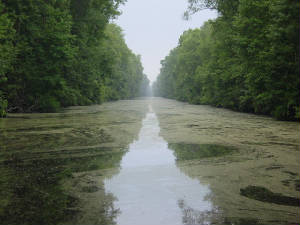
|
| Dismal Swamp and the Civil War |
History: The Dismal Swamp Canal,
opened to waterway traffic in 1805, became a "prize of war" during the Civil War. In the early months of fighting, Southerners
used the canal to transport much-needed supplies. W. F. Lynch, Commander of the CSS Sea Bird, a side-wheel steamer,
received naval supplies via the canal when he was in charge of a tiny fleet defending Roanoke Island.
After Roanoke Island fell into Union hands on February 8, 1862, Lynch decided to take a position at Elizabeth City. However,
on February 10, units of Admiral Goldsborough's fleet captured Elizabeth
City and the Sea Bird was rammed and sunk by the USS Commodore
Perry. Two other ships fled northward up the Pasquotank River
to the Dismal Swamp Canal en route to Norfolk. While CSS Beaufort made it safely through the canal
to Norfolk, CSS Appomattox was two inches too wide
to enter the locks. Rather than let his ship be captured by the enemy, the captain set it on fire.
Union forces did not attempt to destroy the locks of the Dismal Swamp
Canal until two months later. According to The Rebellion Record,
Frank Moore, Editor, it was known that "Rebel entrenchments and batteries to protect the canal" had been installed at South Mills. Also, this was the time of the "ironclads," with the battle between the Monitor
and the Merrimack at Hampton Roads on March 9, 1862.
Word reached General Burnside, who had established a position in New Bern, that Confederates were building ironclads in Norfolk and intended to bring them south through the Dismal Swamp
and Currituck Canals. Therefore, General Burnside ordered General Jesse L. Reno to move troops to South Mills and blow up
its locks, then proceed to the Currituck Canal
and destroy its banks.
| Civil War Battle of South Mills Map |
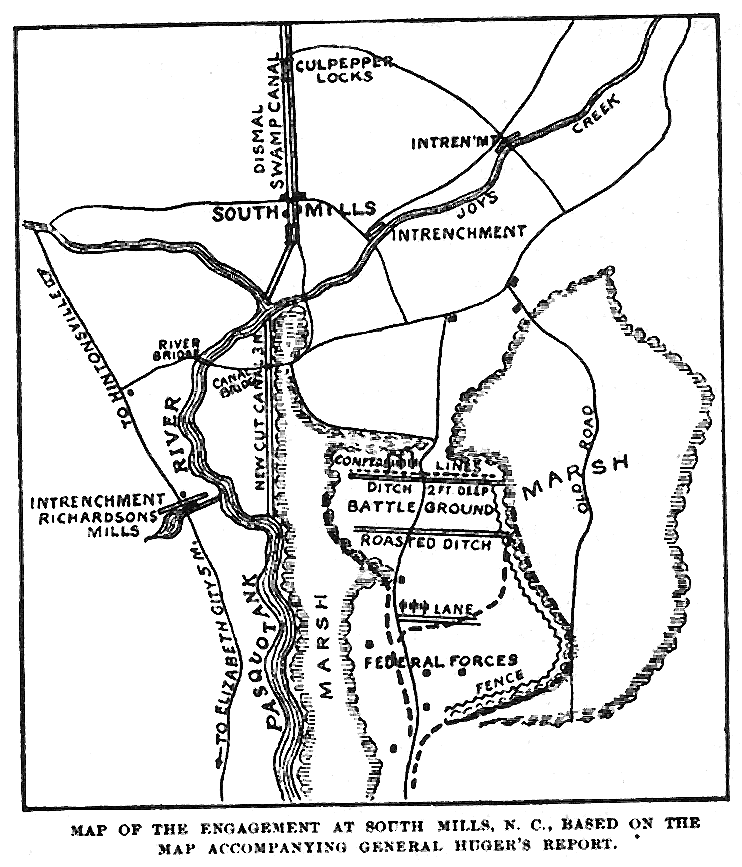
|
| Union and Confederate Battlefield Positions |
| The Great Dismal Swamp |
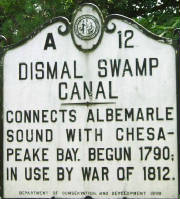
|
| Dismal Swamp and the Civil War |
General Reno moved his command of 3,000 men from Roanoke Island on April 17
and transported them by water to nearby Elizabeth City. From
there, they marched north to South Mills, accompanied by three wagons loaded with explosive materials to be used on the locks.
After an exhausting all-night march, at noon Reno's men encountered
the Third Georgia Regiment, commanded by Colonel A. R. Wright, about three miles below the locks. The two sides engaged at
the edge of the woods at the north end of Sawyers Lane.
On April 19, for five hours, the 750 defenders withstood all Union assaults
until their artillery commander, C.S. Captain W. W. McComas, was killed. Running
low on ammunition and to avoid being flanked, Wright withdrew his troops to a new position behind Joy's Creek, about a mile
away. Unaccustomed to the oppressive heat and after sustaining numerous casualties, the Union forces did not pursue and, in
fact, rapidly withdrew back to their transports near Elizabeth
City, leaving their dead and wounded behind and the Canal intact.
Soon afterwards, however, Norfolk surrendered on May 10, 1862, and Union troops transported goods on the Canal. Leroy
G. Edwards, Collector of Tolls for the Dismal Swamp Canal Company, testified: "In the latter part of the summer of 1862, the
U.S. forces took possession of the work.
They gave us much trouble ... goods were carried through under military permits. I asked payment of tolls, which were refused."
During this time, a sizable number of Confederate
sympathizers and deserted soldiers were in hiding in the Swamp, making periodic raids on Federal boats. Official Army records
document that on December 5, 1863, Brigadier General Edward A. Wild led forces from Norfolk
to South Mills and Camden Court House to capture these Rebel forces.
However, the two small steamers carrying
supplies for his forces were by "some unaccountable blunder ... sent astray through the wrong canal" and did not catch up
with General Wild until he arrived at Elizabeth City. In the vastness of the Great Dismal Swamp, the Rebels eluded this expedition.
All settlements discovered on this march were burned and confiscated, innocent men were hanged and women were taken as hostages.
North Carolina Governor Zebulon B. Vance referred to General Wild's actions as a "disgrace to the manhood of the age. Not
being able to capture soldiers, they war upon defenseless women. Great God! What an outrage!" The
Union forces returned to Norfolk on December 24, leaving a
trail of destruction behind them.
| South Mills & The Great Dismal Swamp Region |
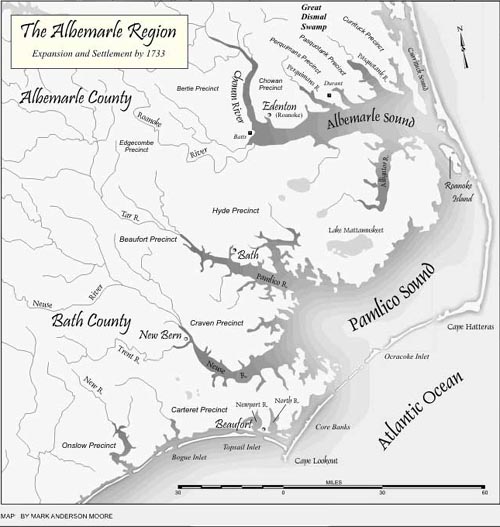
|
| North Carolina Civil War Map of Battles |
| South Mills & Great Dismal Swamp |
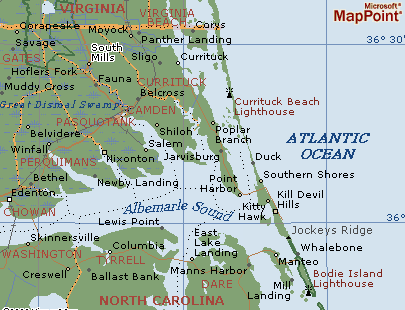
|
| North Carolina Coast Civil War History |
Analysis: On April 19, 1862, Confederate troops repelled
Union troops for five hours at Sawyer’s Lane, retreating to fortifications 2 miles north at Joy’s Creek only after
being outflanked from the east. Both sides claimed victory: the North because they captured the field and the South because
they prevented the destruction of the Dismal Swamp Canal Locks, 3 miles northwest in South Mills, North Carolina.
The Confederate troops retreated north to the locks at Wallaceton in Virginia during the night to prevent being outflanked
from the east again. Union forces retreated back to their transports at Chantilly on the Pasquotank River around 10:00 p.m.,
fearing the Confederates were receiving reinforcements from Norfolk. A Confederate force of about four thousand men was sent
from Suffolk through Gates County in an attempt to cut the Yankees off from their ships, but they arrived too late.
General Jesse Reno’s Union forces consisted of three regiments from Roanoke Island and two from New Bern. They
were accompanied by a detachment from the 1st New York Marine Artillery and underwater explosives expert, Professor Benjamin
Maillefert, of New York City. Their objective was to blow up the locks at South Mills, cutting off the major route for supplies
to Norfolk and denying Confederate ironclads a route to the Albemarle Sound. The fear of ironclads was unfounded; the canal
was far too shallow and narrow for the CSS Virginia’s passage.
The Union battle plan called for Colonel Rush Hawkins and his Fourth Brigade from Roanoke Island to land at Chantilly
under the cover of darkness, followed by a twelve mile forced march to South Mills. They were to capture and hold the bridge
over the Pasquotank River below South Mills, preventing the seven Third Georgia companies posted on the Pasquotank County
side of the river from crossing over into Camden County. Reno was to follow with his two regiments from New Bern and the explosives
to blow up the locks.
| Battle of South Mills |
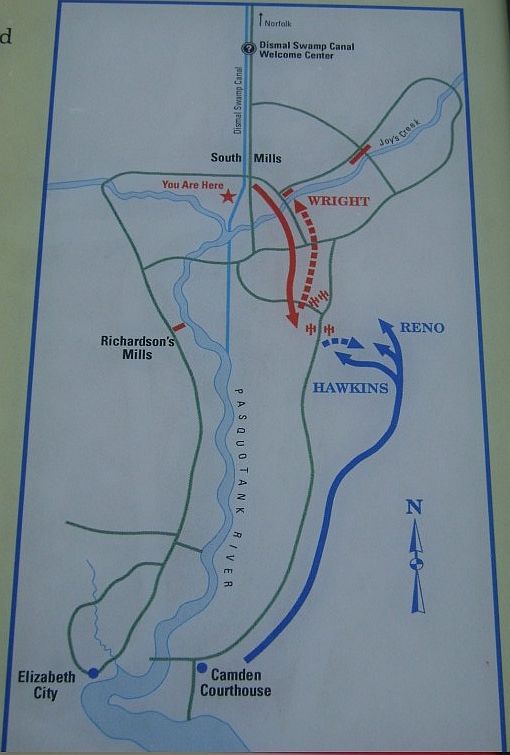
|
| Battle of South Mills |
(Right) Union and Confederate forces maneuvering
for position during the Battle of South Mills. Although this was a minor engagement, it proved that Union forces
could now push inland and operate with relative ease against a variety of targets, such as bridges, warehouses, railroads
and depots, and the state's infrastructure.
In the darkness, Hawkins and his Fourth Brigade took a wrong turn onto Gumberry
Road, arriving at Belcross around dawn. They stopped at the house of Lieutenant Alonzo Bell on Lamb’s Road to eat breakfast.
Hawkins recognized Bell as one of the paroled captives from the Battle of Hatteras Inlet. After eating, the Union column continued
down Lamb’s Road towards South Mills, an unintended detour of about 5 miles. Hawkins blamed the blunder on treachery
by his local guide.
In the meantime, Reno’s column left Chantilly at dawn and followed
the most direct route past Camden Court House, stopping to rest at Lamb’s Corner around 10:00 a.m. While stopped,
clouds of dust and flying colors were espied approaching from the east down Lamb’s Road. Reno called his men into line
of battle and prepared to fire on the approaching force, thinking Hawkins was already at South Mills holding River Bridge.
The supposed enemy turned out to be Hawkins and his worn-out men, several hours late. They fell in behind the fresher troops
of the Second Brigade and continued northward towards Sawyer’s Lane.
Around noon, Confederate artillery fire halted the Union column. The
Union battery was hurried to the front of the column and a three hour artillery battle ensued, followed by an hour of combat
between the infantry units. The Union advance was held up by five companies of Colonel Ambrose Wright’s Third Georgia
Infantry and three guns of the Giles Light Artillery, a total of about four hundred men holding off over three thousand until
outflanked from the east around 5:00 p.m. The Confederates withdrew to entrenchments north of Joy’s Creek; the exhausted
Yankees declined to pursue them. The Battle of South Mills was over.
On the return to their ships at Chantilly, Union troops destroyed the
bridge over Sawyer’s Creek, set prisoners free from the jail, stripped the store of an outspoken Southern sympathizer
of its merchandise, reportedly stole the gems of the local Shrine Hall, and used the Camden Court House as a rest stop. The
route back to Chantilly was strewn with materials looted during the return trip.
| South Mills and Great Dismal Swamp Canal Locks |
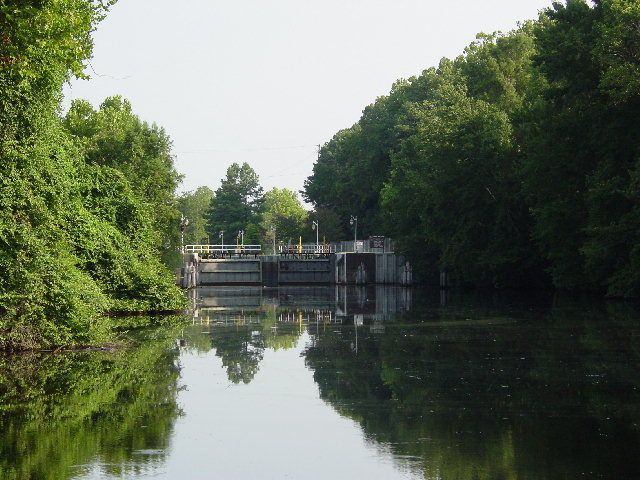
|
| Civil War Battle of South Mills, North Carolina |
(Sources listed at bottom of page.)
Recommended Reading: The Civil War in the Carolinas
(Hardcover). Description: Dan Morrill relates the experience
of two quite different states bound together in the defense of the Confederacy, using letters, diaries, memoirs, and reports.
He shows how the innovative operations of the Union army and navy along the coast and
in the bays and rivers of the Carolinas affected the general course of the war as well as
the daily lives of all Carolinians. He demonstrates the "total war" for North
Carolina's vital coastal railroads and ports. In the latter part of the war, he describes
how Sherman's operation cut out the heart of the last stronghold
of the South. Continued below...
The author
offers fascinating sketches of major and minor personalities, including the new president and state governors, Generals Lee,
Beauregard, Pickett, Sherman, D.H. Hill, and Joseph E. Johnston. Rebels and abolitionists, pacifists and unionists, slaves
and freed men and women, all influential, all placed in their context with clear-eyed precision. If he were wielding a needle
instead of a pen, his tapestry would offer us a complete picture of a people at war. Midwest Book Review: The Civil War in the Carolinas by civil war expert and historian
Dan Morrill (History Department, University of North Carolina at Charlotte, and Director of the Charlotte-Mecklenburg Historical
Society) is a dramatically presented and extensively researched survey and analysis of the impact the American Civil War had
upon the states of North Carolina and South Carolina, and the people who called these states their home. A meticulous, scholarly,
and thoroughly engaging examination of the details of history and the sweeping change that the war wrought for everyone, The
Civil War In The Carolinas is a welcome and informative addition to American Civil War Studies reference collections.
Recommended Reading:
The Civil War on the Outer Banks: A History of the Late Rebellion
Along the Coast of North Carolina from Carteret to Currituck With Comments on Prewar Conditions and an Account of
(251 pages). Description: The ports at Beaufort, Wilmington, New Bern and Ocracoke, part of the Outer Banks (a
chain of barrier islands that sweeps down the North Carolina coast from the Virginia Capes to Oregon Inlet), were strategically
vital for the import of war materiel and the export of cash producing crops. Continued below...
From official records, contemporary newspaper accounts, personal journals of the soldiers, and many unpublished
manuscripts and memoirs, this is a full accounting of the Civil War along the North Carolina coast.
Recommended Reading: Ironclads and Columbiads: The Coast
(The Civil War in North Carolina) (456 pages). Description: Ironclads and Columbiads covers some of the most
important battles and campaigns in the state. In January 1862, Union forces began in earnest to occupy crucial points on the
North Carolina coast. Within six months, Union army and
naval forces effectively controlled coastal North Carolina from the Virginia
line south to present-day Morehead City.
Continued below...
Union setbacks in Virginia, however, led to the withdrawal of many federal soldiers from North Carolina,
leaving only enough Union troops to hold a few coastal strongholds—the vital ports and railroad junctions. The South
during the Civil War, moreover, hotly contested the North’s ability to maintain its grip on these key coastal strongholds.
Recommended Reading: The
Civil War in Coastal North Carolina (175 pages) (North Carolina Division of Archives and History). Description: From the drama of blockade-running to graphic descriptions of battles
on the state's islands and sounds, this book portrays the explosive events that took place in North Carolina's
coastal region during the Civil War. Topics discussed include the strategic importance of coastal North Carolina, Federal occupation of coastal areas, blockade-running, and the impact of
war on civilians along the Tar Heel coast.
Recommended Reading: Storm
over Carolina: The Confederate Navy's Struggle for Eastern North Carolina. Description: The struggle for control of the eastern
waters of North Carolina during the War Between the States
was a bitter, painful, and sometimes humiliating one for the Confederate navy. No better example exists of the classic adage,
"Too little, too late." Burdened by the lack of adequate warships, construction facilities, and even ammunition, the
South's naval arm fought bravely and even recklessly to stem the tide of the Federal invasion of North
Carolina from the raging Atlantic. Storm
Over Carolina is the account of the Southern navy's struggle in North
Carolina waters and it is a saga of crushing defeats interspersed with moments of brilliant and even
spectacular victories. It is also the story of dogged Southern determination and incredible perseverance in the face
of overwhelming odds. Continued below...
For most of
the Civil War, the navigable portions of the Roanoke, Tar, Neuse, Chowan, and Pasquotank rivers were
occupied by Federal forces. The Albemarle and Pamlico sounds, as well as most of the coastal towns and counties, were also
under Union control. With the building of the river ironclads, the Confederate navy at last could strike a telling blow against
the invaders, but they were slowly overtaken by events elsewhere. With the war grinding to a close, the last Confederate vessel
in North Carolina waters was destroyed. William T. Sherman
was approaching from the south, Wilmington was lost, and the
Confederacy reeled as if from a mortal blow. For the Confederate navy, and even more so for the besieged citizens of eastern
North Carolina, these were stormy days indeed. Storm Over Carolina describes their story, their struggle, their history.
Sources: albemarle-nc.com/camden/history/civilwar;
southmillsbattle.home.coastalnet.com; National Park Service; NC Office of Archives and History; Official Records of the War
of the Rebellion; Microsoft MapPoint.
|

